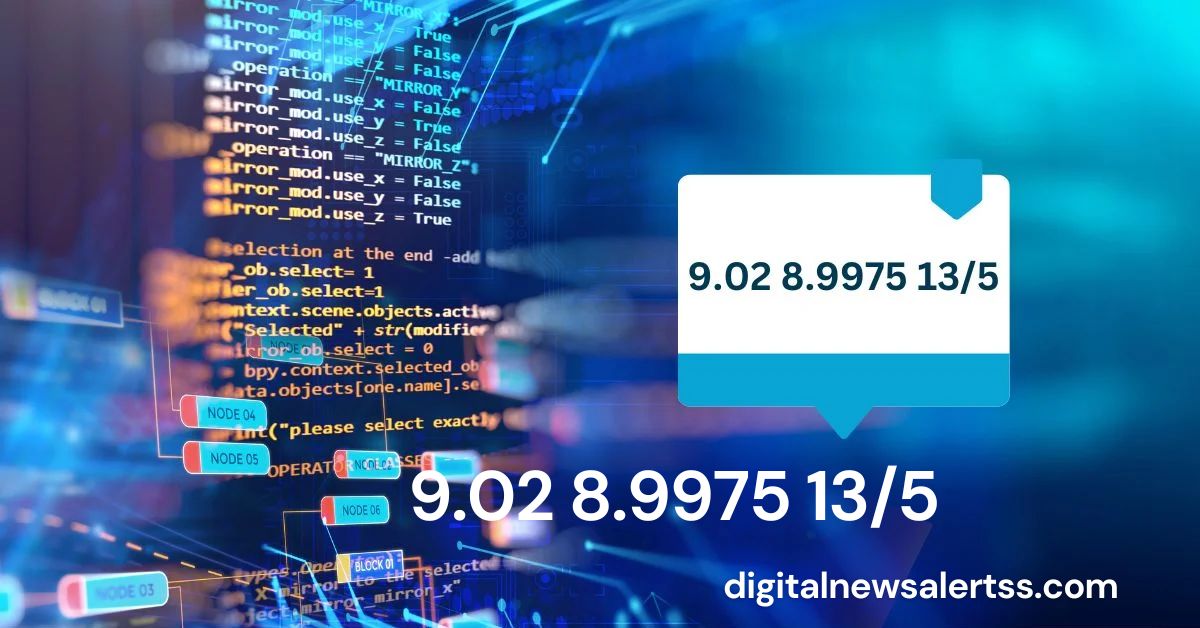Have you ever wondered about the meaning behind numbers like 9.02, 8.9975, or 13/5? These seemingly random combinations of digits and symbols actually represent important concepts in mathematics. In this article, we’ll explore the world of decimals and fractions, using the specific example of “9.02 8.9975 13/5” to guide our journey. Whether you’re a student looking to improve your math skills or simply curious about numbers, this comprehensive guide will help you understand these concepts in a way that’s easy to grasp.
What Are Decimals and Fractions?
Before we dive into our specific example of “9.02 8.9975 13/5”, let’s start with the basics. Decimals and fractions are two different ways to represent numbers, especially those that fall between whole numbers.
Decimals: A Closer Look
Decimals use a system based on powers of 10 to represent parts of a whole number. In our example, 9.02 and 8.9975 are both decimals. Here’s how to understand them:
- The number to the left of the decimal point represents whole units.
- Each place to the right of the decimal point represents a smaller fraction of a whole unit.
For example, in 9.02:
- 9 represents the whole number part
- 0 represents the tenths place (0/10)
- 2 represents the hundredths place (2/100)
So, 9.02 can be read as “nine and two hundredths.”
In 8.9975:
- 8 is the whole number
- 9 is in the tenths place (9/10)
- 9 is in the hundredths place (99/100)
- 7 is in the thousandths place (997/1000)
- 5 is in the ten-thousandths place (9975/10000)
Fractions: Breaking It Down
Fractions represent parts of a whole using two numbers: a numerator (top number) and a denominator (bottom number). In our example, 13/5 is a fraction. Here’s how to understand it:
- The numerator (13) tells us how many parts we have
- The denominator (5) tells us how many equal parts the whole is divided into
So, 13/5 means “thirteen fifths” or thirteen parts out of five equal parts of a whole.
Comparing 9.02, 8.9975, and 13/5
Now that we understand what these numbers represent, let’s compare them:
- 9.02
- This is slightly more than 9
- It’s the largest of the three numbers
- 8.9975
- This is very close to, but slightly less than 9
- It’s the smallest of the three numbers
- 13/5
- This can be converted to a decimal by dividing 13 by 5
- 13 ÷ 5 = 2.6
- It falls between 8.9975 and 9.02
So, in order from smallest to largest: 8.9975 < 13/5 < 9.02
Why Are These Numbers Important?
You might be wondering why we’re focusing on these specific numbers. While “9.02 8.9975 13/5” might seem like a random collection, it actually represents an interesting set of closely related values that help illustrate important mathematical concepts:
- Precision in measurement: 8.9975 shows how decimals can represent very precise measurements.
- Approximation: 9.02 could be an approximation of a more complex number.
- Fractions in real-world scenarios: 13/5 might represent a ratio or division in a practical situation.
Real-World Applications
Understanding numbers like “9.02 8.9975 13/5” isn’t just about math class. These concepts have real-world applications:
In Finance
Decimals are crucial in financial calculations. For example:
- A bank interest rate of 8.9975% on a savings account
- A stock price of $9.02 per share
In Cooking
Fractions are common in recipes:
- A recipe might call for 13/5 cups of flour (which would usually be simplified to 2 3/5 cups)
In Science and Engineering
Precise measurements often use many decimal places:
- The speed of light is approximately 299,792,458 meters per second, often rounded to 2.998 x 10^8 m/s
In Construction
Both decimals and fractions are used in measurements:
- A piece of wood might need to be cut to 9.02 inches long
- A drill bit size might be described as 13/5 of an inch
Converting Between Decimals and Fractions
Sometimes, you might need to convert between decimals and fractions. Here’s how:
Decimal to Fraction
To convert a decimal to a fraction:
- Write the decimal as a fraction over powers of 10
- Simplify if possible
For example, to convert 9.02 to a fraction:
- 9.02 = 902/100
- This can be simplified to 451/50
Fraction to Decimal
To convert a fraction to a decimal, simply divide the numerator by the denominator:
13/5 = 13 ÷ 5 = 2.6
The Importance of Number Sense
Understanding numbers like “9.02 8.9975 13/5” helps develop number sense, which is crucial for:
- Estimating: Quickly recognizing that 13/5 is between 2 and 3
- Mental math: Realizing that 9.02 is just a little more than 9
- Problem-solving: Choosing the appropriate level of precision for a given situation
Common Misconceptions
When dealing with decimals and fractions, some common misconceptions include:
- Thinking more decimal places always means a larger number (8.9975 is actually less than 9.02)
- Assuming fractions are always less than 1 (13/5 is greater than 1)
- Believing that decimals are more precise than fractions (both can be equally precise)
Tips for Working with Decimals and Fractions
- Practice estimating: Try to guess where a number falls before calculating
- Use visual aids: Number lines can help visualize the relationships between numbers
- Connect to real-life situations: Think about how these numbers might appear in everyday life
- Use technology wisely: Calculators can help, but understanding the concepts is crucial
The Beauty of Numbers
While “9.02 8.9975 13/5” might seem like a random string of numbers, it represents the elegant way mathematics allows us to express quantities with precision. From the simplicity of whole numbers to the infinite possibilities of decimals and the clear ratios of fractions, numbers give us the power to describe and understand our world in remarkable detail.
Conclusion
Understanding concepts like “9.02 8.9975 13/5” is more than just a mathematical exercise. It’s about developing a deeper appreciation for the numbers that surround us every day. Whether you’re balancing a checkbook, following a recipe, or pursuing a career in science or engineering, a solid grasp of decimals and fractions will serve you well.
Remember, math isn’t just about getting the right answer – it’s about understanding the relationships between numbers and how they represent the world around us. So the next time you encounter a decimal or fraction, take a moment to think about what it really means and how it relates to other numbers you know.
FAQs
What’s the difference between 9.02 and 9.2?
While they might look similar, 9.02 is equal to 9 and 2/100, while 9.2 is equal to 9 and 2/10. 9.2 is the larger number.
How do I know when to use a decimal versus a fraction?
Decimals are often used in measurements and calculations, while fractions are common in cooking and construction. Use whichever form is most appropriate for your situation.
Can all fractions be converted to terminating decimals?
No, some fractions result in repeating decimals. For example, 1/3 = 0.3333… (repeating)
Why is it important to understand numbers like “9.02 8.9975 13/5”?
Understanding these numbers helps develop number sense, which is crucial for estimating, mental math, and problem-solving in various real-world situations.
How can I improve my skills with decimals and fractions?
Practice regularly, use visual aids like number lines, connect the concepts to real-life situations, and don’t be afraid to use technology as a learning tool.
What’s the easiest way to compare numbers in different formats (like decimals and fractions)?
Convert them all to the same format. Usually, converting fractions to decimals is the easiest approach.
Are there any tricks for mental math with decimals?
Yes! For example, to add 0.1 to a number, you can simply add 1 to the tenths place. Practice with small numbers to build confidence.
How precise should I be when using decimals in real life?
It depends on the situation. In scientific measurements, you might need many decimal places, but for everyday use, two or three decimal places are often sufficient.
What’s the history behind the decimal system?
The decimal system has roots in ancient civilizations, but the modern decimal point was introduced in the 16th century by mathematicians like Stevinus and Napier.
How are decimals and fractions used in computer programming?
Programming languages often use floating-point numbers for decimals and have specific ways to handle fractions. Understanding both concepts is crucial for accurate calculations in coding.



